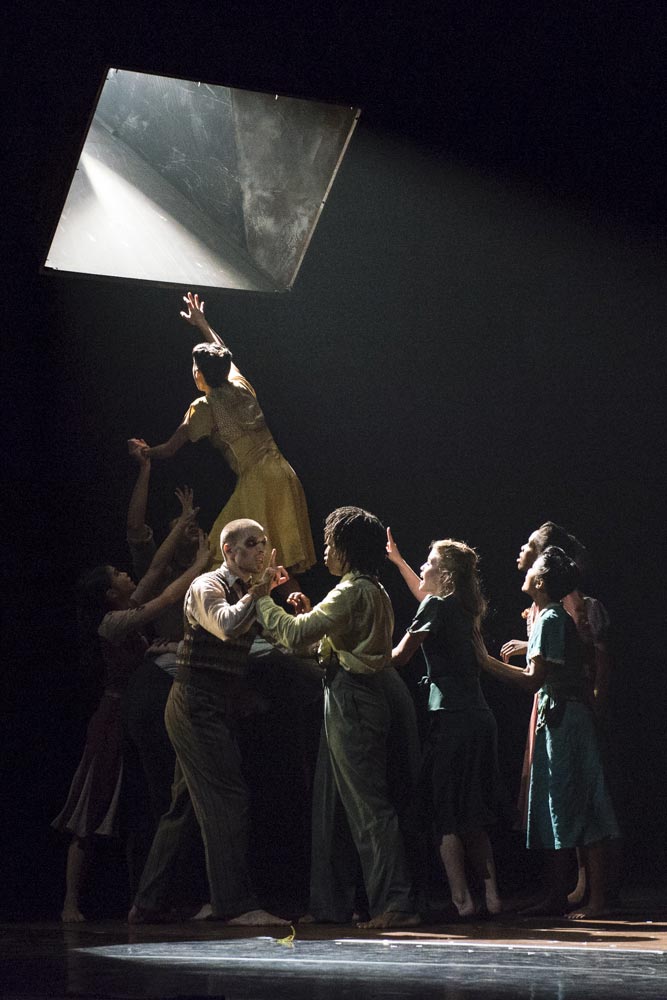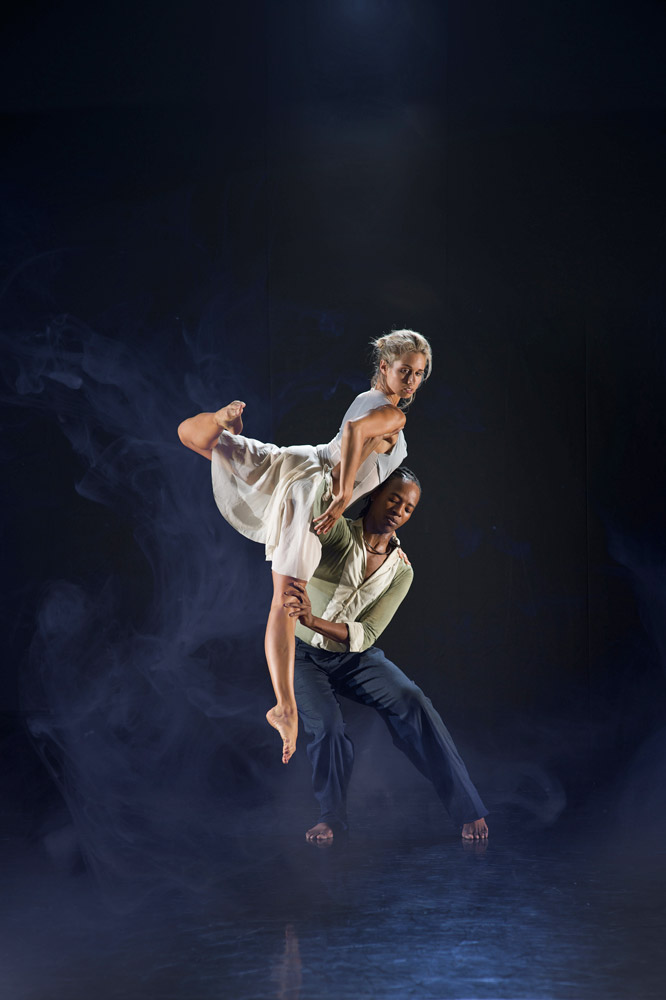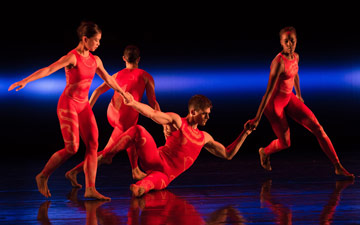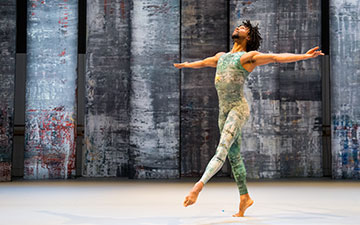
© Foteini Christofilopoulou. (Click image for larger version)
Rambert
The Castaways, Subterrain, The Comedy of Change
London, Sadler’s Wells
22 October 2013
Interview with Ashley Page – choreographer of Subterrain
Gallery of The Castaways pictures by Foteini Christofilopoulou
www.rambert.org.uk
www.sadlerswells.com
Advance publicity for this mixed bill was dominated by The Castaways, a new work for Rambert, this season, by American Choreographer, Barak Marshall; and this, despite the opening night in London welcoming the world premiere of Ashley Page’s Subterrain. These two works book-ended Mark Baldwin’s cleverly-styled The Comedy of Change, which dates back to 2009, being made to celebrate the 150th anniversary of the publication of Darwin’s On The Origin of Species.

© Foteini Christofilopoulou. (Click image for larger version)
Marshall is a choreographer not much known in the UK. Born and bred in Los Angeles, the son of an accomplished performance artist (Margalit Oved, a long-serving member of the Inbal Dance Company) he became Batsheva’s resident choreographer in 1999. After a horrific leg injury in 2001, Marshall abandoned dance for several years before being enticed back to make new work in Israel in 2008. In The Castaways he shows an eclectic range of creative influences, mixing spoken text, retro music and powerful ensemble dancing, and he does so in a setting that is deliberately austere with the cast of twelve held captive in a confined space.
Conceptually, it seemed like Tanztheater meets Kenneth MacMillan’s The Burrow. In that 1958 ballet (a time in which this piece may also have been set), a group of terrified people are hiding in a small room from an unspecified threat. In The Castaways, its hard to say whether the group is more terrified of the madman within (an emotionless Russian soldier with a predilection for shooting people in the head); or of the unknown menace that lies at the other end of a piece of giant ductwork peering down at the castaways like some demonic metal alien with a very large mouth, through which light shines and packages are occasionally regurgitated. It appears to be the only link to the outside world for this odd assortment of a dozen captives.

© Foteini Christofilopoulou. (Click image for larger version)
There are many stand-out moments in Marshall’s work, in its humour, visual impact and through the regular break-away from the spoken text in synchronised group dancing to catchy tunes of a middle-eastern, gypsy or Yiddish style. A woman has a wooden base “hammered” onto the soles and stilettos of her high-heeled shoes and is then turned upside-down to become a lectern for a male speaker. Balloons filled with powder are popped to signify a gunshot (although this device becomes serially over-used). And, best of all, a “romeo” has a series of potential lovers held – Lilac Fairy style – above his head, each expressing an outpouring of love, while he remains obliviously asleep in bed, although standing up, covered by a blanket and with a pillow behind his head. But, in spite of all these clever innovations, the structure of the work takes on an increasing predictability and is let down by a generic failure of the performers to be convincing with their spoken text. There is a sequence – especially redolent of the work of Pina Bausch – where three women stand front of stage, breaking the fourth wall by cattily discussing members of the audience. It lacked impact and the desired comedic effect. Each of the castaways is introduced early on by a hat-wearing narrator and they all appear to have a story but none of these identities had any traction and I had soon forgotten who they were.

© Chris Nash. (Click image for larger version)
It has taken almost a year for Ashley Page’s new work to make it from studio to stage, during which time original cast members have moved on. Subterrain is driven by Page’s choice of music: two hugely contrasting pieces by Mark-Anthony Turnage (one rude and rambunctious, the other surprisingly gentle and lyrical) which are joined together by a specially-commissioned and very effective musical bridge by the electronic composer, Aphex Twin. Page has created one long series of duets for five heterosexual couples, some performed in isolation while others occupy all five pairs simultaneously. The movement is classical with an uneven edge, and Page’s flair for musicality, especially in creating diverse rhythmic movement patterns, is clear to see.
The dancers’ clothing (designed by Jon Morrell) could hardly have been more diverse, with the ten performers dressed as uniquely as possible: one guy wore a tight leather jacket, another was sprayed into shorts while a third resembled the retro vest-and-kilt-wearing hero on the front of the Scott’s Porage Oats packet. There is evidently no narrative intent, but the more lyrical Turnage music, which closes the work, begins to see dancers changing partners (there is also some sinister voyeurism from a hooded spectator watching from the side-lines) and the curtain closes on the movement still in flow, giving a deconstructive flavour that somehow this dance continues in its subterranean space long after the audience has stopped watching. At nearly 40 minutes, this is a long piece of pure dance but one that is so well structured that it seemed to have flown by much more quickly.

© Chris Nash. (Click image for larger version)
The Comedy of Change is another non-narrative work that comes with a resolute intention, in this case to evoke thoughts about evolution. Mark Baldwin begins with seven white chrysalises, lying on the stage, from which the dancers emerge one-by-one, dressed in strikingly sexy unitards with all-white fronts and black backs. This significant visual impact (from designer Georg Meyer-Weil) and a bespoke score composed by Julian Anderson provides an excellent framework across which Baldwin has woven a rich tapestry of movement to illustrate his ideas about the context of evolutionary change. As in the opening work, there are particularly strong opportunities for the dancers to shine in uncompromising duets.

© Hugo Glendinning. (Click image for larger version)
In an important sense this title unwittingly sums up the company’s overall delivery of three such diverse works. As dancers, the Rambert performers are an exceptionally rare elite but they have yet to master the comedy of change in the evolution of their art to successfully encompass the spoken aspects of physical theatre. I’m more than happy to keep them as dancers.

















You must be logged in to post a comment.